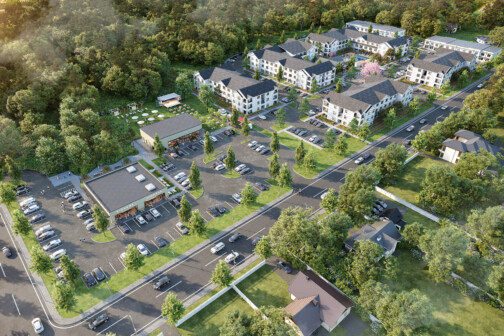People from all walks of life I encounter keep asking me, “why are you designing and building more office buildings?” I have been an architect for thirty-plus years and spent many of those focused on designing corporate office buildings on the core and shell side and more recently on the workplace interiors side. In a parallel universe, I would love to write novels and maybe use this line: “his eyes were distant, I just knew his mind was in another place so remote that no one would bring him back to the here and now…” Okay, maybe I will stick to architecture. Here is my point though: the connotations of the very idea of being remote are not conducive to the progression of most business models, the growth of your company in its chosen industry. I do not mean that to seem extremist or universally true but consider the small sampling of what it means to operate a company based on remote work and the evidence suggests community togetherness and in-person collaboration still prevail.

One year ago, I wrote my first blog post about how “People are Doing Everything Everywhere” in an article entitled “Defining Workplace”. What has changed in the last year, two years from the onset of the worldwide Covid-19 pandemic? I am not sure what if anything changed in one year mired in pandemic fog, but what we do know is that every company in the U.S., and maybe even the world, is grappling with the extremes of the traditional office versus the remote office and that experimentation is rampant. I have heard every end of the spectrum and will share specific examples. I give major credit to the corporate office developers who continue to be aggressive in creating new work environments. The evolution of the workplace was underway before the pandemic but now it is infused with the rocket fuel it may have needed to become more dynamic and more versatile than ever.
Anecdotally, these stories are so intriguing to me: One of our largest clients saw many of their middle to upper management buying houses far away from the main headquarters during the pandemic with the intent of mostly remote working going forward. I have not heard officially how well that was received. Personally, I realized a dream of having a second home in Taos, New Mexico, and have had success working there sporadically in the last two years. Keyword: sporadically, as in occasionally. Company A might be back in the office 1 day a week – yes, ONE day – while Company B works Tuesdays through Thursdays at the office. Our own company, BOKA Powell, at one end of the spectrum has been back full time since February of 2021. Our highly creative and collaborative culture is the better for it and it shows in our latest work and recent successes. We are experimenting with a new initiative whereby every employee may work from home two days a month just by requesting and communicating with their direct reports. There are 21.7 workdays in a month, so that’s almost 10% of days that offer the flexibility of being remote. By the way, these are not additive, they are “use it or lose it” benefits.
At the opposite end of the spectrum is the software company we are designing multiple new locations for their corporate offices, and they will use these new spaces to attract their employees back to the office after over two years of remote work. Much has been written by myself and others on how to attract the workforce back into the office, so I will not dwell on that. Rather, I would like to discuss the effects of remote working.
The Dallas Morning News published two articles on Sunday, May 1st that shed some light on the dilemma. The first article was republished from an article by Seth Borenstein of the Associated Press and the punchline was “Video meetings dampen brainstorming because we are so hyper-focused on the face in the box that we don’t let our eyes and mind wander as much. Staring isn’t good for creativity.” Zoom meeting fatigue is at an all-time high and for someone who routinely finds themselves on Zoom calls with 30-60 people, I am amazed this article did not also explore the attention deficit that is widespread on zoom calls. In a race to be relevant and respond to all that tugs at our lives, we attempt to multi-task and the two-hour zoom call has become the place to hide in plain sight while tackling five things at once. The Borenstein article did reference studies that show one-to-one video calls are highly effective compared to group calls and even in-person meetings and I understand that. Video calls are not all bad. We have noticed and the article references it, that soft-spoken people and shy personality types have seen the new meeting forum as a place to find a voice.
The second article from the Sunday, May 1, Dallas Morning News was republished from Bloomberg and related to the design of conference and meeting spaces within companies. The hybrid office is here to stay and creating a productive environment that supports that is critical. “Zoom rooms” dedicated to video conferencing and the actual shaping of rooms to focus on video monitors are challenging planners and designers to try new geometries. Camera sight lines are critical so that all faces can be seen, but the absolute most important design consideration is the audio quality. How remote is too remote? Here is the answer: If you do not have good video quality or excellent audio quality, you have no business working remote. Those are the fundamental tools for having a chance at success.
To be fair, there are also studies that have shown positive impacts about the work habits and general mental well-being of remote workers. The Australian-based company Airtasker surveyed 1,004 full-time employees – 505 of whom were remote employees – throughout the U.S. about their work habits and productivity. The results indicate that remote workers are more productive than their office-based counterparts. The study found the following:
- Remote employees work an additional 1.4 more days per month than in-office employees, which is nearly 17 additional workdays a year.
- Remote employees take longer breaks on average than office employees (22 minutes versus 18 minutes, respectively), but they work an additional 10 minutes a day.
- Office workers are unproductive for an average of 37 minutes a day, not including lunch or breaks, whereas remote employees are unproductive for only 27 minutes.
- 15% of remote workers said their boss (or other employees) distracted them from work, which is less than the 22% of office-based employees who said the same thing.
While these statistics may encourage both employees and employers to implement a work-from-home program, remote employees also reported higher levels of stress and more difficulty finding work-life balance than office-based workers. Much has yet to be discovered regarding mentoring and upward mobility in companies with remote workers. Ultimately, working remotely can be effective, but it must be put into practice correctly, and it may not be the best situation for every employee or every business. The hybrid office will become even more viable with the onslaught of software-based solutions such as Slack, Miro, Asana, Podio, Trello, and the Microsoft suite led by Teams and OneNote. If you have not heard of some or all these options for productivity, you may not be ready for the revolution that is upon us. The physical workplace is not going away, but how and when we use it is being redefined before our very eyes by the complex physical, psychological, and sociological issues before us.
Andrew Bennett is a partner at the architecture firm BOKA Powell in Dallas.





